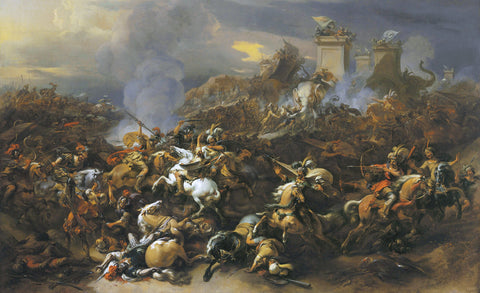
How Did a Ladder Almost Kill Alexander the Great?
When Alexander the Great’s homesick soldiers mutinied on the banks of India’s Hyphasis (present-day Beas) River in 326 BC, he had to abandon his eastward march. Then, to define the eastern boundary of his empire, the Macedonian warrior-king led his army south along the Hydaspes (Jhelum) River. Allied Mallian and Oxydracian tribes fielding 90,000 infantry, 10,000 cavalry and 900 chariots—an army twice the size of Alexander’s—sought to deny the invaders passage through their territory.
As it was the rainy season, however, the Mallians and Oxydracians had yet to combine forces, since they usually didn’t campaign in such conditions. The Greco-Macedonians, on the other hand, were willing and able to fight year- round. Alexander led his army into Mallian territory, along the Acesinea and Hydratois (Chenab and Ravi) rivers. Establishing a camp at the confluence of the Hydaspes and the Acesinea, Alexander first secured his lines of communication and then marched down the Acesinea to establish a base at its confluence with the Hydratois. Next, he led a large force east across the desert between the rivers, while a smaller force followed behind to sweep up any Mallians who managed to avoid the main Greco-Macedonian column or attempted to escape north. That threw the Mallians further off-balance. Alexander was now well positioned for a drive south. Unable to choose a leader or coordinate with the Oxydracians, the Mallians retreated behind the walls of their various settlements.
GET HISTORY 'S GREATEST TALES—RIGHT IN YOUR INBOX
Subscribe to our HistoryNet Now! newsletter for the best of the past, delivered every Wednesday.
Close
Thank you for subscribing!
Submit
Having crossed the desert, Alexander moved against the northernmost Mallian cities. The Mallians were so ill prepared that some were surprised outside their walls. The Macedonian cavalry cordoned off the region by occupying a city to the southeast and sealing off escape routes to the north and west. Alexander then took the city of Atari, opening the road to the capital of Malli (possibly present-day Multan, Punjab). As Alexander approached Malli, enemy forces assembled on the river’s far (west) bank. Realizing how the Mallians feared his army, Alexander sent just his cavalry on the attack. Although the Mallians initially broke and fled, they turned and fought when they saw how few Macedonians they faced. By utilizing their greater skill and mobility, the Macedonian cavalry hung on until infantry arrived, the Mallians ultimately losing heart and fleeing.
The survivors retreated within Malli’s formidable citadel. While some of Alexander’s men began undermining the citadel walls, others brought up scaling ladders. The impatient warrior-king went up one ladder with a pair of bodyguards. Spotting Alexander on the ramparts, a host of Greco-Macedonians fearing for his safety crowded the ladders, which broke under their weight. Cut off and targeted by the Mallians, Alexander leaped down into the citadel, fighting for his life. Many of his men scaled the walls while others bodily broke down the gates. They soon reached Alexander, who’d taken an arrow through the lung. As rescuers bore him away, his troops began to slaughter every Mallian they could find. Order was only restored when Alexander had recovered enough to emerge from his tent.
Alexander’s victory over the Mallians compelled the Oxydracians to surrender and secured the region for the Macedonian empire. The campaign also daunted other Indian tribes and rulers, many of whom hastened to offer their submission.
Lessons
Do the unexpected. Look for innovative ways to seize the strategic initiative and keep the enemy off-balance so they cannot respond effectively.
Be everywhere. Alexander divided his forces and tasked subordinates with missions designed to keep pressure on the enemy. Such tactics made it impossible for the Mallians to effectively concentrate their forces.
Know when to be patient. Alexander’s hasty decision to lead from the front at Malli almost got him killed and threatened to derail a brilliant campaign.
